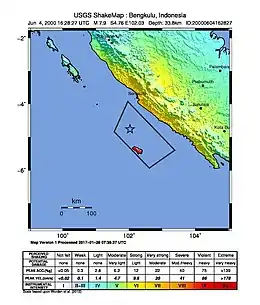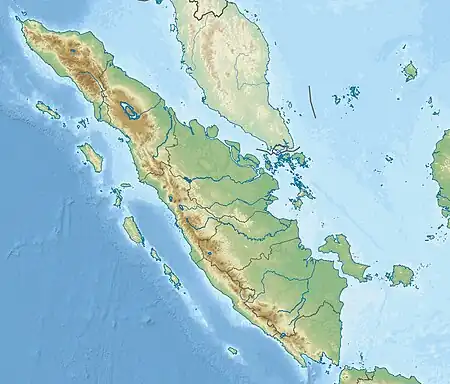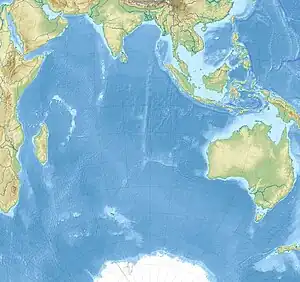2000 Enggano earthquake
The 2000 Enggano earthquake struck at 23:28 local time on June 4 with a moment magnitude of 7.9 and a maximum Mercalli intensity of VI (Strong). The event occurred off the coast of southern Sumatra, Indonesia near Enggano Island. There were more than 100 fatalities and up to 2,585 injuries. Over 730 aftershocks shook the area afterwards, one just eleven minutes after the mainshock.
 | |
 | |
| UTC time | 2000-06-04 16:28:26 |
|---|---|
| ISC event | 1736014 |
| USGS-ANSS | ComCat |
| Local date | June 4, 2000 |
| Local time | 23:28 |
| Magnitude | 7.9 Mw [1] |
| Depth | 35 km (22 mi) [1] |
| Epicenter | 4.61°S 102.06°E [1] |
| Type | First subevent strike-slip Second subevent megathrust[2] |
| Areas affected | Indonesia |
| Max. intensity | VI (Strong) [3] |
| Aftershocks | 6.7 Mw June 4 at 16:39 [4] |
| Casualties | 103 dead [5] 2,174–2,585 injured [5] |
This was the first and southernmost in a series of very large to great Sumatran earthquakes in the 2000s to rupture almost the entire western part of the Sunda megathrust, most notably including the 9.1–9.3 2004 Indian Ocean earthquake, but also the 8.7 2005 Nias–Simeulue earthquake, and the 7.9–8.4 September 2007 Sumatra earthquakes.
Background and tectonics
Indonesia is well known for strong earthquakes: the 2000 Enggano event marked the beginning of an ongoing period of seismic activity in the area, highlighted by the 2004 Indian Ocean earthquake. The 2000 Enggano earthquake took place at the southeastern end of the fault segment that ruptured during the 1833 Sumatra earthquake. This group of earthquakes, in addition to the 2005 Nias–Simeulue earthquake, all ruptured along the megathrust that forms the interface between the Australian and Sunda Plates.[6] This event was the only one not to cause a tsunami.
Earthquake
The earthquake involved the rupture of two different faults with different mechanisms. The first subevent ruptured a north–south striking fault within the Australian Plate with a left lateral strike-slip mechanism. The earthquake rupture propagated northwards until it reached the megathrust, triggering the second subevent along the Sunda megathrust itself. The strike-slip rupture probably represents slip on a pre-existing fracture zone, similar to the likely cause of the M 7.9 earthquake that struck about 1,000 km to the south on 18 June 2000 with a similar mechanism.[2]
Damage and casualties
At least 46 people were killed, 940 were injured and 1,008 affected houses were reported in the Bengkulu area. Thirty-nine deaths, 1,245 injuries and 90 percent of houses were destroyed on Enggano Island.[7] In the village worst struck, several hundred structures were reported in ruins.[8][9] An aftershock measuring 6.2 struck on June 7.[10]
Aftermath and response
International relief teams arrived in the region within several days.[11] Relief efforts were impeded by fallen telephone poles, which blocked the supplies.[8] The main problem found in the affected areas was a lack of water supply and electricity, these facilities having been cut off by oscillation.[8] Pope John Paul II expressed his "sincere sympathy" for those families stricken by the earthquake.[12] He called for a rapid international response to the quake, and said he would keep its victims in his prayers.[12] A Taiwanese rescue team was sent to help victims of the tremor, the first country to take part in rescue efforts from Asia. The United States donated US$ 25,000 instantly to relief organizations, Japan offering a grant of US$140,000 and Australia US$143,000 in addition to a two-person team of emergency relief examiners.[13]
Wharton Basin event
  | |
| UTC time | 2000-06-18 14:44:13 |
|---|---|
| ISC event | 1736624 |
| USGS-ANSS | ComCat |
| Local date | June 18, 2000 |
| Local time | 22:44 |
| Magnitude | 7.9 Mw |
| Depth | 10 km (6.2 mi) |
| Epicenter | 13.802°S 97.453°E |
| Type | Intraplate |
| Areas affected | Indonesia |
| Max. intensity | II (Weak)[14] |
| Tsunami | 0.3 m (0.98 ft)[14] |
| Aftershocks | 17 (As of June 27 2000)[15] |
| Casualties | None |
Two weeks later on June 18, another magnitude 7.9 event occurred about 1,000 kilometers (620 mi) to the southwest in the Wharton Basin. At the time, it was the largest intraplate earthquake in the Indian Ocean until the 2012 Indian Ocean earthquakes.[2]
References
- ISC (2014). ISC-GEM Global Instrumental Earthquake Catalogue (1900–2009). Version 1.05. International Seismological Centre.
- Abercrombie, R. E.; Antolik, M.; Ekström, G. (2003). "The June 2000 Mw 7.9 earthquakes south of Sumatra: Deformation in the India–Australia Plate". Journal of Geophysical Research. 108 (B1): ESE 6–1. Bibcode:2003JGRB..108.2018A. doi:10.1029/2001JB000674.
- USGS. "M7.9 - southern Sumatra, Indonesia". United States Geological Survey.
- USGS. "M6.7 - southern Sumatra, Indonesia". United States Geological Survey.
- USGS (September 4, 2009). PAGER-CAT Earthquake Catalog. Version 2008_06.1. United States Geological Survey.
- Sieh, K. "The Sunda megathrust: past, present and future" (PDF). Retrieved 2009-11-04.
- OCHA (9 June 2000). "Indonesia - Earthquake OCHA Situation Report No. 4". ReliefWeb. Retrieved 14 May 2023.
- "Indonesia appeals for help following Sumatran earthquake". RTÉ News. June 5, 2000.
- Tim Radford (July 6, 2000). "Just an everyday disaster". The Guardian. Retrieved June 4, 2009.
- "Photo Essay 6/8/2000 - Earthquake in Indonesia". Time Magazine. 2000-06-08. Archived from the original on August 15, 2000. Retrieved 2008-07-29.
- UN Office for the Coordination of Humanitarian Affairs (2000), UNDAC Team Mission Report Bengkulu Earthquake, Sumatra, Indonesia 6–16 Jun 2000, ReliefWeb
- "Pope Comforts Indonesian Quake Victims". Catholic World News. 2000-06-06.
- Catherine Sung (June 8, 2000). "Rescue team on the way". Taipei Times. Retrieved June 4, 2009.
- "M 7.9 - South Indian Ocean". United States Geological Survey.
- "USGS earthquake catalog". United States Geological Survey.
Further reading
- Milsom, J.; Abercrombie, R. E. (2003). The June 2000 Enggano earthquake, South Sumatra, and the role of the Mentawai Fault. EUG Joint Assembly, Abstracts from the meeting held in Nice, France, 6–11 April 2003. Egs - AGU - Eug Joint Assembly. p. 9923. Bibcode:2003EAEJA.....9923M.
External links
- M7.9 Enggano Island-Bengkuku Earthquake, 2000 – Amateur Seismic Centre
- The International Seismological Centre has a bibliography and/or authoritative data for this event.
- ReliefWeb's main page for this event.